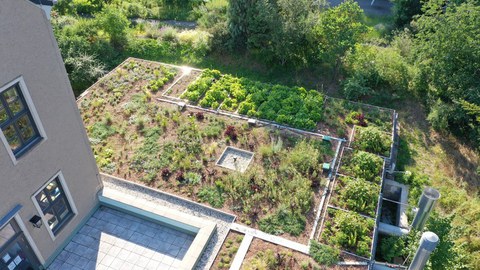Aug 12, 2024
Final report on the model project Integral Water Management: Green Roof

Research green roof in the Botanical Garden of TU Dresden
The DBU-funded research project Integral Water Management: Investigations to optimize the effects of simple intensive green roofs on building and urban climate, water balance and vegetation diversity in the urban environment through irrigation with treated grey water was successfully completed in 2023; the results of the project can now be read in the final report. The project was realised jointly by the Professorships of Landscape Architecture, Urban Water Management, Building Climatology and Meteorology as well as the Botanical Garden of TU Dresden.
Green roofs can contribute to improving the thermal environment in urban areas, with the cooling effect of evapotranspiration being an important aspect. The use of this evaporation capacity during longer periods of drought and heat is severely restricted in low-layer green roofs due to their limited retention capacity. Adapting the layer structure to greater heights and supplementary irrigation can counteract this. However, the use of drinking water for irrigation is neither sustainable nor economically viable.
The aim of the project (duration 24 months) was to investigate whether the effects predicted or proven in previous research projects for extensive green roofs can be stabilized and optimized for a simple intensive green roof in a typical green roof situation under real climatic conditions through irrigation with treated grey water. For this purpose, a simple intensive green roof was investigated in long-term tests under real installation and different operating conditions and the influence of changing hydraulic loads. The use of pre-treated graywater as a sustainable irrigation option was also used to investigate the influence of the substance input on the capabilities of the soil body.
The report is essentially based on the evaluation of the measurement results from the 2022 vegetation period. The results of the very dry and hot year in terms of weather conditions clearly show that the vitality and aesthetics of simple intensive green roofs can be improved compared to the less or non-irrigated reference fields, the more continuously the water supply is kept within the range of the maximum field capacity. However, it also became clear that there is no linearity between vitality and irrigation quantity, but that with medial irrigation it was possible to achieve ratings that in some cases were only slightly behind the maximum irrigation. Even in fields with a minimal irrigation regime, a satisfactory appearance and summer flowering can still be achieved throughout the year compared to areas with drought-tolerant species. The increased irrigation quantities can also increase the growth height and the potentially evaporating vegetation volume on a species-specific basis. No detrimental effects on the appearance of the vegetation due to irrigation with pre-filtered gray water could be determined up to the 2022 growing season.
Green roofs can be an important component of an urban water balance that approximates natural conditions. Irrigation significantly increases the evaporation component and compensates for the low storage capacity of the roof substrate. Continuously occurring grey water is suitable for irrigation and the irrigation quantities can be optimized for maximum evaporation performance. However, due to the higher average water storage of the substrate as a result of irrigation, less water can be retained when it rains, resulting in higher runoff peaks and volumes. An optimization that takes rain retention and increased evaporation into account must therefore strike a balance between these two objectives. The material conversion processes and concentration cause high nitrate and organic material contents in the runoff water from green roofs, which should be taken into account for reuse or discharge into water bodies or soil.